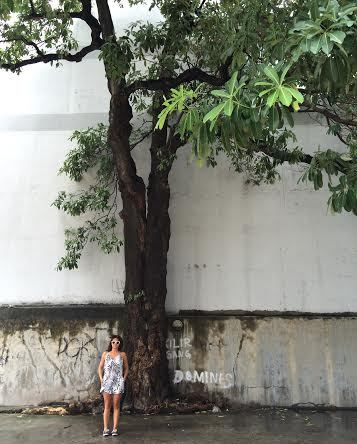I’ve been called a tree-hugger more than once. No, I’m not a hippie, but I really love trees, especially in cities.
Studies reveal that being around trees is good for one’s health. We know trees remove pollutants from the air, protect the soil from erosion to prevent flooding and cool our concrete jungle.
But their psychological benefits are also noteworthy. Looking at green makes us happy and influences how healthy we feel and we don’t need data to know this is true.
The way some people admire iconic architecture, I am struck with awe when I see a mango tree towering five stories and stretching half as wide along a busy road.
After a day of monotonous high-rises, tasteless advertisements and traffic, it feels nourishing to spend a few moments admiring the color of leaves, the shape of a canopy.
And where there are trees, there are animals. Waking up to the sound of birds gives me a positive start to the day—something the sounds of honking cars and construction noise cannot. These opportunities help me relax and reduce any stress.
Trees contribute to urban livability as much as any other element. Under a tree there is shade and, on a hot and sunny or rainy day, cover is everything. I don’t feel anxious waiting to cross a road when there is a tree on a corner. It’s pleasant walking or commuting on my bike down a tree-lined street. I’ve been caught in a sudden downpour and found protection as good as an umbrella under a canopy of broad leafs.
These problems can be addressed with built solutions, but there’s an intimate, personal quality to a tree that is missing in a metal or concrete-covered pedestrian overpass, for instance. As a friend pointed out: you can hug trees; you can’t hug buildings.
Native trees
Around Metro Manila, streets and places are named for the native trees which have found their way into parking lots, front yards, medians, cemeteries. The narras, talisays, molaves, kamunings, some of which can take 30 years to reach full maturity, are part of our urban history and local identity. When we see a bani, a dungon, a kalantas on the street, we know we are in the Philippines and not, for instance, New Hampshire.
Luckily for us, we have 3,500 species of native trees to help give us a sense of place. Some, like the ditas, even have blooming seasons, adding a dimension of time. Every year, locals and visitors flock to see the cherry blossoms in Japan; with the right landscape design, Filipinos could be celebrating similar periods of transition.
Trees are literally a low-hanging fruit when it comes to urban design in the Philippines. We are a city in a tropical country, and that means foliage flourishes without the slightest care. It rains half the year; leaves and stems and branches and trunks sprout dense, whether intended or not.
Along esteros, natural vertical gardens creep up concrete walls. Vacant lots are carpeted with growth. Trees older than most of us break through sidewalks and walls, insisting not to be ignored. There is green tucked like a secret into corners all over the city.
Three years ago, I was inspired to plant a guerrilla garden in an abandoned flower bed outside the Grand Boulevard Hotel in Malate. At first I carried buckets of water to the site, but after a few months lost discipline.
Then a construction barrier was erected, preventing access to the garden. I was sure the garden would die, but after three years it’s completely outgrown the flower bed, spilling into the surrounding area. A lime green papaya tree now towers above the blue steel barrier.
I am not alone in my enthusiasm for these natural urban assets. The recent destruction of 31 native trees at the Army Navy compound was decried in media. The reduction of the green space in Ayala Triangle for another high-rise is a cause for concern. Such situations show a need for balance between city and nature.
A first step is to spread the love, so there’s love to save. Instead of a weekend trip to your local mall, go to one of the city greens. Spend time marveling at the ancestral trees in La Mesa Ecopark, UP Diliman, Arroceros Park, Rizal Park, Quezon Memorial Circle, Manila South Cemetery and Washington SyCip Park.
And as you go about your daily life, make an effort to notice what is growing around you. Stop for a moment and look up.









































